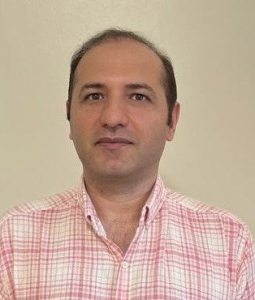
Dr. Sayed Bateni has spent his professional career researching and learning about natural hazards, terrestrial remote sensing, machine learning, data assimilation and coupled land-atmosphere systems behavior. He received his Bachelor of Science in civil and environmental engineering from Isfahan University of Technology in 2002, Master of Science from Sharif University of Technology in 2005 and Ph.D. from the Massachusetts Institute of Technology in 2011. He is currently a professor in the University of Hawaiʻi at Mānoa’s Department of Civil, Environmental and Construction Engineering and Water Resources Research Center.
Bateni arrived at The University of Alabama to serve as the 2024 summer visiting scholar for the Cooperative Institute for Research to Operations in Hydrology, or CIROH, where he is also the principal investigator of multiple projects. In a project funded by the National Science Foundation and NASA, he is developing synthetic aperture radar-based, or SAR-based, flood mapping. The overall goal of this project is to advance the knowledge of SAR-based flood mapping by developing and validating state-of-the-art computational tools.
In 2023, Hawaii suffered catastrophic wildfires on the island of Maui. In two projects funded by the Hawaii state legislature, Bateni plans to develop a wildfire forecast system for Hawaii and generate wildfire susceptibility and vulnerability maps. This early detection system will allow authorities to issue timely warnings to enhance the preparedness of first responders and enable the broader community to take proactive measures, such as evacuation planning and home risk mitigation. By providing timely information, these forecasts can help reduce the total area burned and mitigate the overall impacts of wildfire through rapid response and suppression efforts.
In another project funded by the U.S. Department of Agriculture, Bateni and his team are using AI approaches to forecast evapotranspiration and rainfall for optimal irrigation scheduling. The main goal of this project is to develop a climate-smart tool to conserve irrigation water for farmers.
To further his research, Bateni uses various machine learning, metaheuristic optimization and data assimilation approaches in his projects. He has integrated weather stations, soil types and crop coefficients in Hawaii into the CropManage online irrigation tool, making it operational for farmers. He is also developing gridded near real-time weather data, such as air temperature, humidity and wind speed, and wildfire risk maps for Hawaii.
When asked why he chose CIROH while taking a break from teaching in Hawaii, Bateni said his decision to work with CIROH stemmed from their shared objectives in advancing hydrological science and improving hazard prediction and management, which makes it an ideal environment for impactful research and collaboration.
“My research focuses on monitoring and forecasting natural hazards such as wildfire prediction, flood mapping, streamflow forecasting and drought estimation,” said Bateni. “CIROH, on the other hand, supports researchers in advancing the U.S. capability for operational hydrological forecasting of streamflow, floods, droughts and water quality. This alignment between my research interests and CIROH’s mission made it a perfect choice for me.”
Bateni mentioned that by working with CIROH and scientists at NOAA’s National Water Center, also located on UA’s campus, he saw an opportunity to create new collaborations and synergize their efforts to improve the understanding and forecasting of hydrological events. CIROH’s emphasis on operational forecasting and practical applications of research aligns well with his goal of translating scientific insights into actionable tools and strategies that can mitigate the impacts of natural hazards.
“CIROH provides a platform to engage with a community of experts in hydrology and related fields, which is invaluable for exchanging knowledge and staying at the forefront of research developments,” he said. “The chance to contribute to national efforts in enhancing hydrological forecasting and water resource management was a significant motivator in my decision to choose CIROH.”
Overall, Bateni is excited to work with CIROH because of the supportive leadership, collaborative opportunities with NWC scientists and focus on practical applications.
“These factors collectively contribute to the advancement of my research,” said Bateni. “They enable me to make significant contributions to the field of hydrology and natural hazard forecasting.”